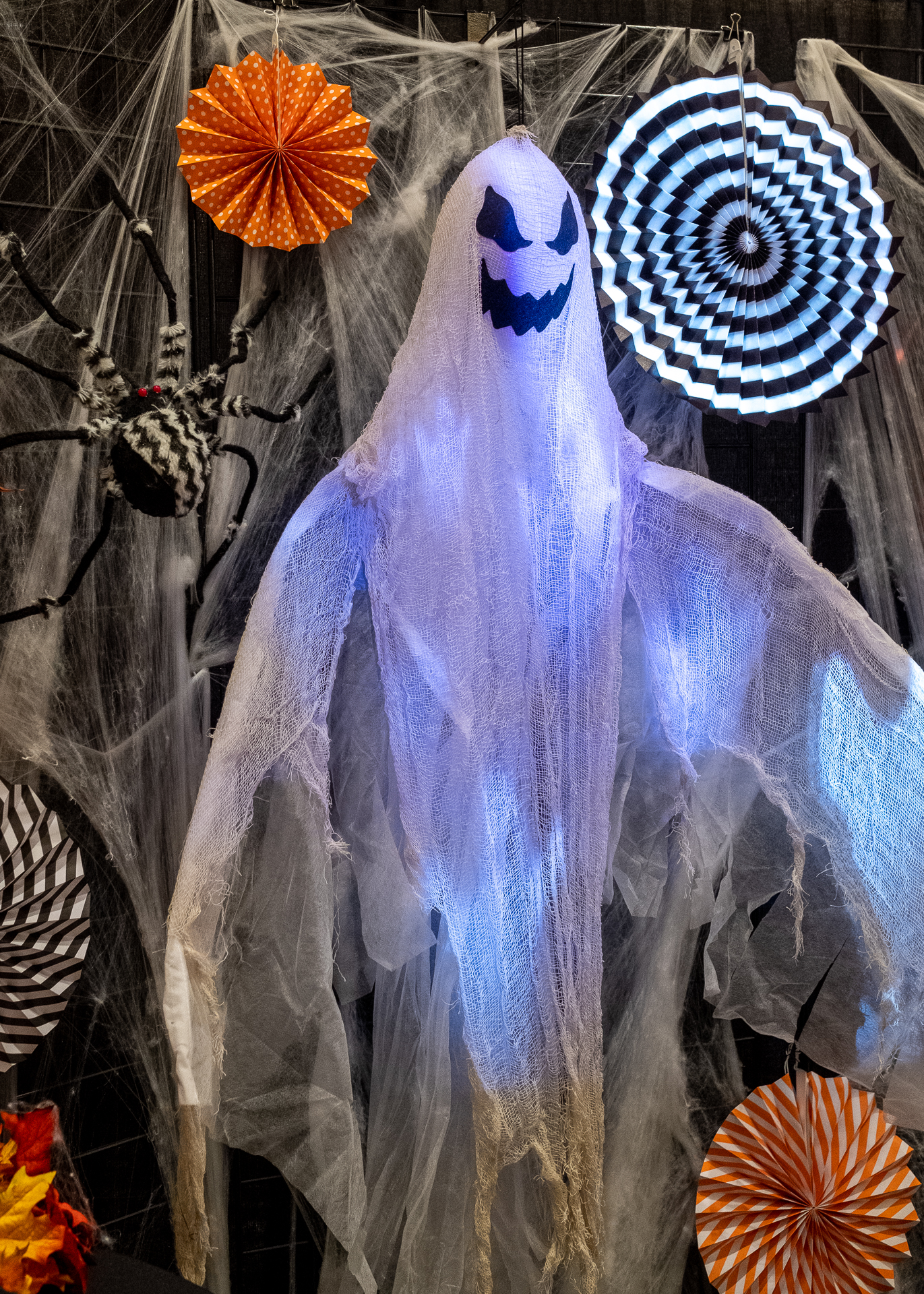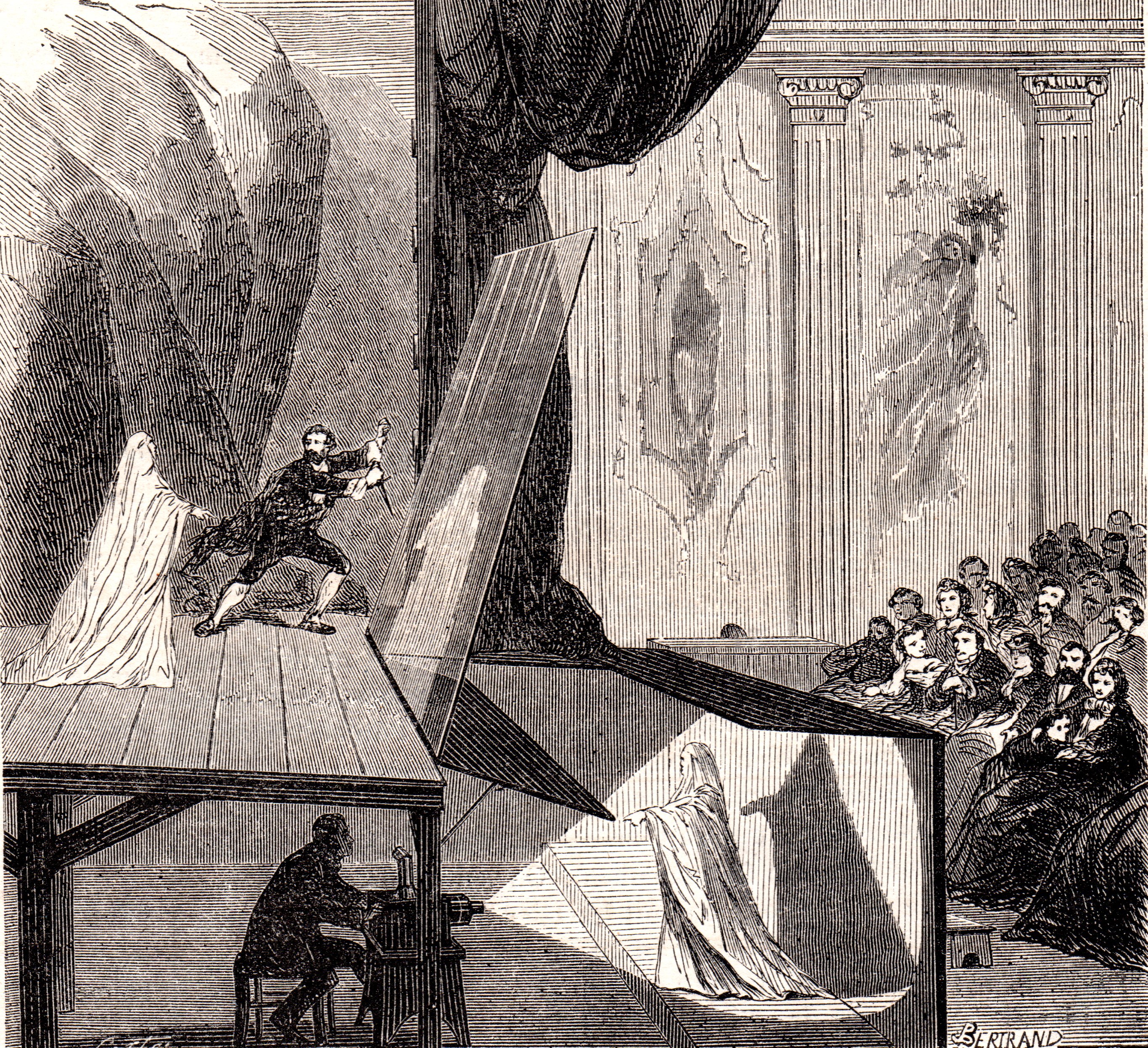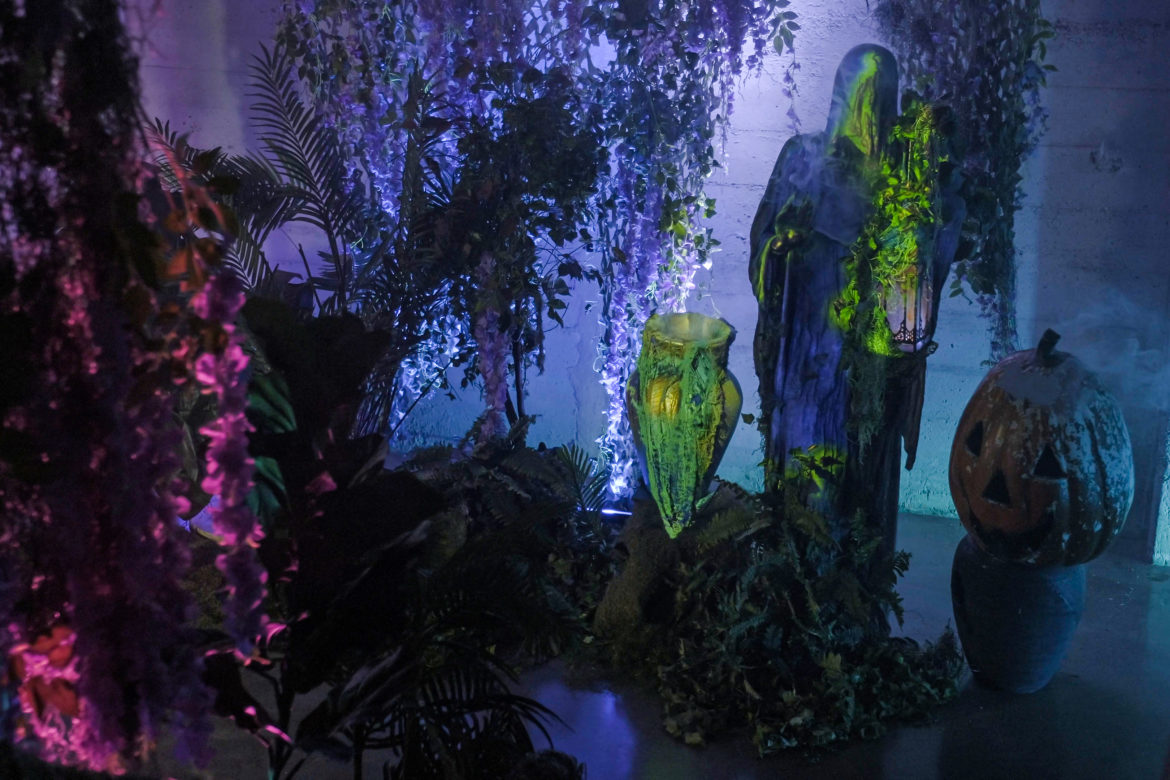Scary Projections: Renaissance to Disneyland
Some of the earliest projected images were horrific, intended to scare audiences and convince them that what they were seeing was real. In 1420, over 100 years before the Magic Lantern existed, Italian renaissance inventors drew the projected figures of winged demons emanating from abstract contraptions. Many of the earliest illustrations of Magic Lanterns in use show projected demons, and the horror genre and projection arts have been closely intertwined ever since.
Projection Mapping and phantasmagoria are similarly connected. In fact, the very first projection mapping installation, Grim Grinning Ghosts at Disneyland’s Haunted Mansion, used 16mm film projection to selectively illuminate marble busts and create the illusion of ghoulish “living” faces. Like many special effects and optical illusions, projection mapping relies on using black backgrounds to mask out parts of a scene and selectively illuminate specific objects and surfaces. You can apply this technique much more easily with modern digital projectors and computer software like Lightform Creator, which allows you to quickly select your areas of illumination using a scan of your scene.
Making 21st Century Jack-o-lanterns with projection mapping.
Halloween Projection Mapping Ideas - Front Projection
If you have a marble bust lying around, you could recreate your own grim grinning ghosts, or you could use the same projection mapping technique on any Halloween decorations. Skeletons, skulls, and calaveras all react well to Lightform creator effects. Projection mapping a face on a pumpkin uses the same concept as Disney’s ghouls. You can make or find videos and gifs of animated jack-o-lantern faces with black backgrounds that will readily map to your gourd, but you can also draw your own design using Lightform Creator’s brush and pen tools, and add fire effects, or whatever new twist you’d like to add to your surface for a unique, customizable jack-o-lantern.

Ghosts on Ghosts
Halloween Projection Mapping Ideas - Rear Projection
Disneyland’s Haunted Mansion also used another much older trick to create the illusion of spirits and apparitions, which may be useful in your own haunted house. Pepper’s Ghost appeared in theatres in 1862, but previous versions of the trick existed in rougher forms well before then. It can be done in a few configurations. The basic setup involves a sheet of glass positioned at the correct angle to appear transparent from the audience’s perspective while reflecting a second scene from a side room towards the audience when the side room is illuminated. The result is the appearance of a transparent “ghost” image on the main stage. If you’ve ever seen a reflection on a window appear superimposed over the real world on the other side of the glass, the concept is the same, just with controlled lighting design.

A Pepper’s Ghost Illusion configured to reflect from the orchestra pit.
This trick is still done traditionally using glass today. Still it has evolved with projection technology. There are a wide range of projection scrims and “holographic screens” designed specifically for creating a Pepper’s Ghost illusion with digital projectors serving as the original side room. Some of the most well-known deceased entertainment figures of our time have been called back to this world at high-profile events in the past decade using large event venue projectors and the largest and most expensive of these special screens. While they are often referred to as holograms, in truth, it’s a projected Pepper’s Ghost that put Tupac, Michael Jackson, and others back onstage with the living.
Rear projection is very similar to the modern Pepper’s Ghost but more straightforward. Instead of projecting towards an angled scrim from the side, the projector is positioned behind a screen to illuminate it from the rear. Rear projection is a great technique to use on windows. Since your window is a rectangular frame anyway, you don’t necessarily have to worry about having a black background in your video assets. If you want to turn your window into a portal to a scene of unspeakable horror instead of using it to conjure spectral apparitions, the window frame will help establish that context.
Any relatively sheer curtain, or a stretched sheet, can be a suitable rear projection screen. There are several window films and treatments specifically designed to turn glass into a projection surface. These window films provide greater visual clarity and better light transmission. This approach is effective with videos of, say, hands desperately clawing to escape, blood splattering against the inside of your windows, or a scene of witches and werewolves silhouetted against a full moon, for example. The point is to have fun with it and maybe make your neighbors reconsider their housing choices. You may want to position your projector at a slight angle to prevent glare from your projector lens from interfering with the illusion. As that angle changes, you’ll see the window frame in your scan appear to skew. To make sure your content is not distorted, you can corner pin your rectangular videos to the window frame using Lightform Creator’s structure tool.
If your projector can produce a frame large enough to cover the whole area, you might consider projection mapping your entire house for Halloween, or maybe just a section of it. If this is the approach you’re thinking about, make sure you have a safe place to put your projector to protect it from the elements. If it’s going to be outside, a projector enclosure is a great way to protect your gear. Pulling the curtains closed during your scan will give you a better scan result, as well as another surface to project on if you’re not using them as rear projection screens. You’ll also probably want to adjust the perspective of any video assets you use in your projection mapping show to align to the architecture, just like with the window scenario we just described.
Interactivity with OSC Triggers
Now, all of these techniques are great for creating spooky projections for Halloween, but whether you’re projection mapping for the trick-or-treaters in your neighborhood or you’re designing a haunted house, keep in mind that some of the best scares are born of surprise. If you want to bring some interactivity to your horror show, OSC triggers can help you increase the fear factor. If you have a blank looping slide in your Creator project, it will play indefinitely without any input to advance. With OSC triggers, you can use a motion sensor to turn on your frightening light show at just the right moment to send passersby running for their lives and then reset to the blank slide and let your automated system wait for the next unwitting victim.
What Will You Create?
While the threshold between our world and the liminal spirit world only blurs during Halloween, with the evolution of projection technology, the boundaries between our imagination and our ability to create get continually thinner. Hopefully, we’ve given you some new ideas for Halloween projection mapping projects and how to use projection mapping for your holiday displays this season, and maybe (once you clean up the viscera), you’ll have some ideas for the holiday season ahead. Happy haunting, and be sure to share your Halloween projections in the comments below.
Author’s Note: the author is not a psychopath, his parents were married on Halloween. Perhaps they are the psychopaths.
Note:
As of August 12th, 2022, Lightform is no longer in business and is no longer providing technical support for the product. Please refer to the Lightform Guide and FAQ for self-help resources.
